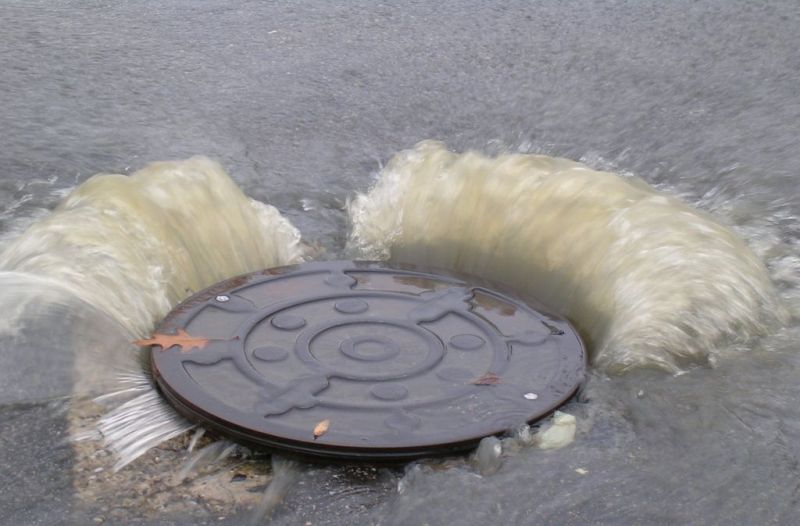WILMINGTON – While central wastewater systems are the cog of a healthy community, the rarely considered maze of underground pipes moving waste and stormwater is vulnerable to hazards, and the problems are getting worse.
The Environmental Protection Agency says wastewater treatment is one of the most used forms of pollution control in the country. The U.S. has a massive system of sewers, pumping stations and treatment plants. Sewers collect wastewater from homes, businesses and industries, carrying it to plants for treatment, where it’s cleaned to standards that make it safe for discharge. But much can go wrong, and does with increasing frequency, contaminating surface waters and putting public health at risk.
Supporter Spotlight
Many failures are unnoticeable to the public because the connected pipes and tunnels that make up the system, especially the collection parts, are underground. Conditions that cause failures here are happening more often on the coast and the outlook is worse for the future, according to recent research.
The study, “Inflow and infiltration in coastal wastewater collection systems: Effects of rainfall, temperature, and sea level,” finds that all that extra water flowing into wastewater collection systems in coastal North Carolina has become a big problem that’s driven by varying combinations of rainfall, seasonal temperature effects on groundwater levels and variation in sea level at high tide.
“These effects are sufficiently significant and widespread to challenge the ability of coastal communities to mitigate them,” according to the paper. “Climate change will add to the magnitude of this challenge, as heavier rainfall events, potentially more extreme seasonality, and rising sea levels will increase environmental impacts on wastewater collection system performance.”
The authors characterize wastewater collection and treatment systems as vital to public health, economic growth and environmental quality, but they don’t receive as much consideration for upgrades and improvements as other forms of public infrastructure, according to the paper that North Carolina Sea Grant funded and that’s set to be published in the next issue of Water Environment Research.
Over the two-year study from 2010 to 2011, 19 wastewater collection systems on the coast that use gravity collection systems, showed “statistically significant effects of rainfall, temperature, and sea level as drivers of extraneous flows. … These collective results demonstrate the potential vulnerability of coastal wastewater collection and treatment systems to breaches in system integrity that allow extraneous flows, primarily through groundwater elevation, to drive further infrastructure degradation and environmental pollution.”
Supporter Spotlight
The 19 central wastewater collection and treatment systems studied were identified as along oceanic or estuarine coastlines. The systems “had been experiencing tidal effects and having statistically significant I&I effects. Flows through these systems were then examined statistically for effects of temperature and sea level in combination with and separately from rainfall effects,” according to the study.
The following 19 systems were studied:
- Carolina Beach
- Southport
- Hertford
- Columbia
- Manteo
- Cherry Point
- Kure Beach
- New Bern
- Wilmington South
- French’s Creek
- Wilmington North
- Morehead City
- NE Brunswick
- Washington
- Aurora
- Havelock
- Elizabeth City
- Beaufort
- Belhaven
For more than 90 percent of the central wastewater systems studied, heavy rainfalls, temperature fluctuations in groundwater levels during different seasons and sea level, expressed as daily high-high tides, drove significant effects of I&I, according to the study.
So, what does that mean? Let’s start with inflow and infiltration.
“I&I is an insiders’ thing – wastewater system engineers and operators can tell you all about it, but most folks know nothing, as it’s essentially invisible,” said Larry Cahoon, professor in the biology and marine biology department of the University of North Carolina Wilmington and author of the paper.
“Inflow is water entering the underground system from above, as when rainwater enters around manhole covers. It’s easier to fix but not usually a problem unless a manhole is submerged by floodwater,” Cahoon explained. “Infiltration is leakage of groundwater through joints and cracks in the underground pipe system. This is much tougher to fix and usually much more of a source. Together, inflow and infiltration are termed I&I.”
He explained that operators can see I&I when it increases in the system flow during rain, “which was the basis and starting point for our analyses. When we saw big infiltration values we reasoned that high groundwater levels were the likely drivers.”
Cahoon and Marc Hanke in the Honors College of University of Houston in Houston, Texas, studied the issue of I&I, performed the study and drafted the paper.
Cahoon said he was motivated to do this study because, “Quite honestly, I got pissed off at all the sewage spills in New Hanover County and at the BS the local government folks spewed about them so that I resolved to analyze the problem scientifically and mathematically.”
“Quite honestly, I got pissed off at all the sewage spills in New Hanover County and at the BS the local government folks spewed about them so that I resolved to analyze the problem scientifically and mathematically.”
Larry Cahoon, UNCW
While I&I is essentially invisible to residents, they do notice sanitary sewer overflows, or SSOs, which are quite obvious as manholes overflowing, Cahoon said.
He suspects most folks have never heard of I&I and “have an out of sight, out of mind attitude – flush and forget,” he added. “SSOs are a big driver for shellfishing closures – it’s not all ‘stormwater runoff.’ SSOs are really big health risks in general – this is why we warn people to avoid flood waters.”
Additionally, according to the paper, uncontrolled I&I can end up costing sewer utilities and their customers because of increased water flow into the system that would require an expansion or upgrade of the facilities, and cost of inspection and repairs of system segments with excessive I&I.
“Excessive extraneous flows to coastal sewer systems have recently led in some U.S. coastal communities to installation of new technologies, including vacuum and low-pressure systems, that are much more resilient to leakage and consequent difficulties.”
Cahoon explained the ins and outs of central wastewater systems, which typically include a collection system that receives wastewater from individual sources, usually by gravity flow, and transport the wastewater to a central treatment system.
“Topography almost inevitably forces the use of pump, or lift, stations along the way to pump wastewater over topographic divides until it reaches the sewage treatment facility. The pipes conducting wastewater by gravity are ‘gravity mains’ and the pipes conducting wastewater by pumping are ‘force mains,’” he said, adding that force main pipes have to handle much more pressure as wastewater is forced on an upward slope.
Clay tile, iron, concrete and PVC are materials usually used to build gravity and force mains, with PVC, compared to the others, performing well against the corrosive nature of sewage and the pressure of being buried underground, but all pipe systems have joints that can leak, he said.
“Even the most well-built systems can therefore have some leakage,” Cahoon said, which comes from two sources: inflow and infiltration.
Aging systems usually have more I&I issues, in part because of lower quality pipes and settling, corrosion and other issues that make the problems worse.
With the study, they found that there was a strong pattern reflecting seasonal variation in groundwater levels that were higher in winter and lower in summer because of plants’ drawdown of water levels.
“Big rain saturates the ground. In coastal locations, higher tides raise groundwater,” Cahoon added.
The paper states, “Our analyses indicate that the potential for sea level-driven extraneous flows is temporally and geographically broader than has been appreciated.”
Cahoon went into further detail about the point. “I think that only collection systems in close proximity to sea level have an issue there, although storm surges, which we deliberately left out of our analyses, could certainly change that during storm events. Sea level rise, on the other hand, is slowly submerging all the coastal underground waste collection and treatment systems, and sea water is more corrosive as well.”
He added that septic systems are already in trouble in many barrier island communities, and it will only get worse over time.
“I think very strongly that we need to look hard at different waste treatment technology, particularly if we wish to live in vulnerable locations – high groundwater tables, exposure to sea level rise, etcetera. Septic systems will fail and central systems are extraordinarily expensive to build and maintain properly. Neither is really modern technology,” Cahoon said.










